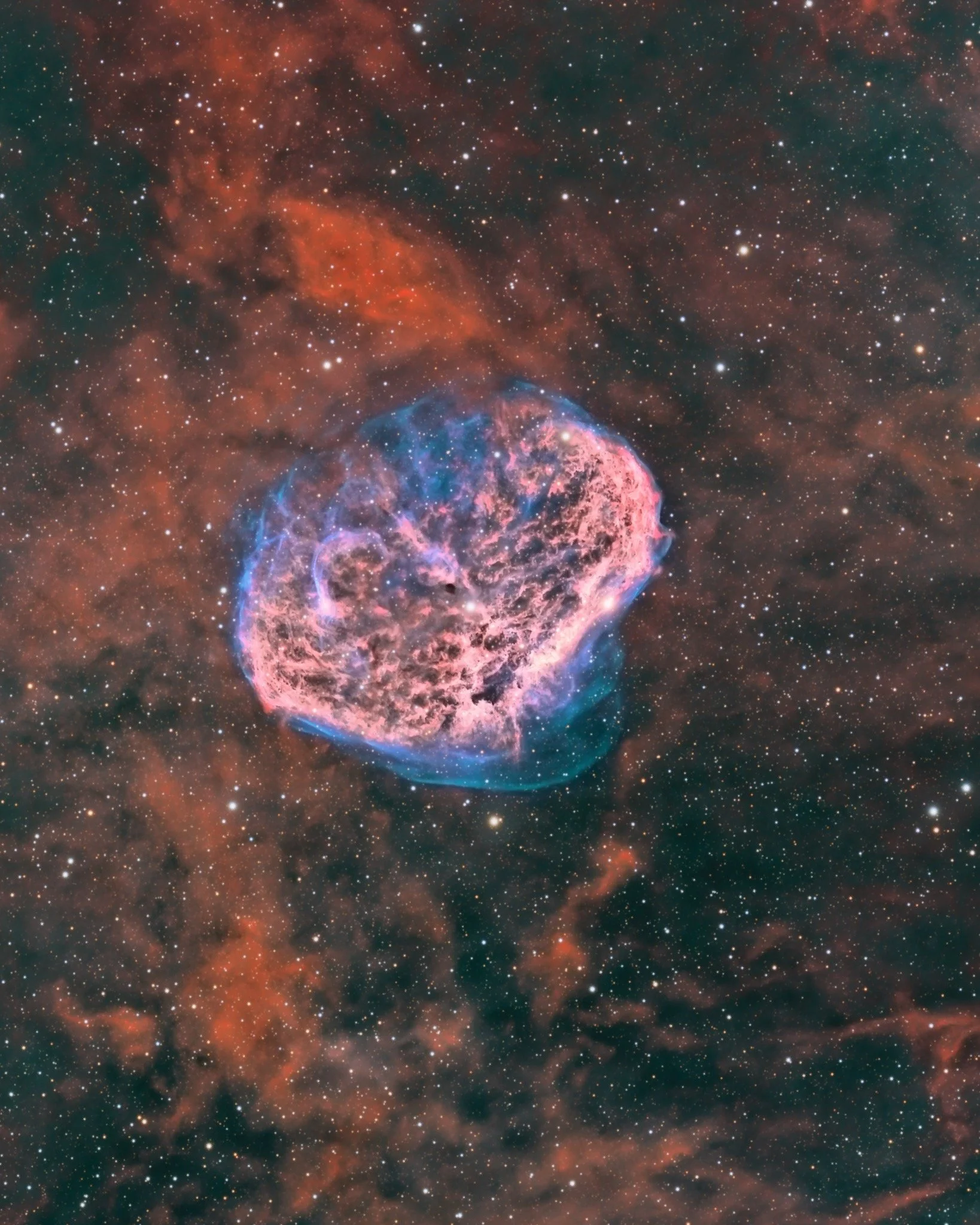
AAPOD2 Image Archives
THE CRESCENT
34hr 31min total exposure time
96x300” Ha
119x300” Oiii
150x60” R
66x60” G
74x60” B
40x Darks360 Flats/Dark Flats06/13-15,06/17-18, 06/21-22, 07/22, 08/03, 08/13/2021Bortle 6/7Calgary, ABSetup#1 - HHOHO 711mm Focal Lengthwilliam optics GT102william optics Flat68iiiantlia filters HO 3nm, 2”antlia filters RGB, 2”sky watcher usa EQ6-R Prozwo asi ASI2600MM-Pro, unity, -10Czwo asi EAFzwo asi EFW 7x2, 2”zwo asi OAG68Mzwo asi ASI290MM-minizwoasi ASIAir Pro
APP, PI, PS, MLR
Copyright: Andrew Lesser
The Crescent and Soap Bubble
Image Description and Details :Imaging telescopes: Askar FRA400 F5.6 · GSO RC8" Carbon TubeImaging cameras: ZWO ASI294MM Pro · ZWO ASI1600MM ProMounts: iOptron CEM26 · iOptron CEM70Guiding cameras: ZWO ASI174MM mini · ZWO ASI120MM MiniFocal reducers: Askar 0.7x Reducer · Astro Physics CCDT67Software: PHD2 PHD 2 · N.I.N.A. · PixInsightFilters: Antlia Ha 3nm Pro · Antlia Oiii 3nm Pro · Astrodon Ha 3nm · Astrodon OIII 3nmAntlia Ha 3nm Pro: 60x600" (10h)Antlia Oiii 3nm Pro: 60x600" (10h)Astrodon Ha 3nm: 12x1800" (6h)Astrodon Ha 3nm: 60x600" (10h)Astrodon OIII 3nm: 32x1800" (16h)Astrodon OIII 3nm: 60x600" (10h)Integration: 62h
Copyright: Tal Akerman
Crescent and Tulip Nebulae Wide field
Image Description and Details : Widefield image of a nebula-dense region in the constellation Cygnus. The image contains the crescent nebula in the top right and the tulip nebula in the lower left.
OIII: 120x300" (10h) bin 1x1
Hɑ: 135x300" (11h 15') bin 1x1
SII: 106x300" (8h 50') bin 1x1
Gain: 111.00; -15C
Total Integration: 30h
Camera: ZWO 183MM Pro
Lens: Rokinon 135 f/2
Mount: Sky-Watcher EQ6R Pro
Copyright: Frank Turina
cygnus mosaic
I have started this imaging project back at 2010. My aim was to make a high resolution mosaic covering the constellation Cygnus. Work like that takes time and patience, especially since I have worked so, that many of the individual sub mosaics or frames have been published as an individual artworks. Here is a poster format presentation about all of longer focal length images used for this mosaic beside wide field panels.
As a result I have now a huge 37 panel (And 58 long focal length sub-panel) mosaic panorama covering 28 x 18 degrees of sky. I have collected photons way over 600 hours during past ten years for this photo. The full size mosaic image has a size of about 25.000 x 15.000 pixels.
In the orientation image above, there are three large supernova remnants visible, first the Cygnus Shell W63 , bluish ring at upper left quarter, secondly the large SNR G65.3+5.7 at utmost right and finally the third is a brighter SNR, the Veil nebula just outside of field of view at bottom center. (Image is partly overlapping with large mosaic but I didn't want to include it yet due to artistic composition.)Beside three supernova remnants there are two Wolf Rayet stars with outer shell formations. NGC 6888, the Crescent Nebula at center of the image and the WR 134, it can be seen as a blue arch just right from the Crescent Nebula, near the Tulip nebula.Next to the Tulip Nebula lays a Black hole Cygnus X-1, it's marked in small closeup image of the Tulip Neula at center right in orientation image above.
There are 37 base panels with shorter focal length tools (300mm f2.8 Tokina and 200mm f1.8 Canon) There is also 59 sub-panels used, they are shot with my old 12" Meade and 11" Celestron Edge scopes.
Copyright: J-p Metsavainio
NGC 6888 Crescent Nebula
Image Description and Details : I photographed this composite image during July-August 2020 in my private observatory (Russia, Moscow region, Makeikha SQM 20.70 mag./arc sec2; Bortle class 4).Technical Data:Telescope: SkyWatcher Quattro 8SShooting Camera: ZWO Optical ASI 1600-MM COOLEDMounts: SkyWatcher EQ 8 PRO MountTelescope Guides: SkyWatcher EvoGuide 50EDGuide camera: ZWO ASI ZWO 120mm miniFocus Reducers: TeleVue Paracorr Type-2Program: Ivan Ionov Fitstacker · by Christian Buil Iris 5.59 · Fitswork 4 · Adobe Photoshop CS 5.1Filters: Astronomik LRGB 1.25 "the Type IIc · Baader Planetarium OIII 1.25" 8.5nm-CCD · Baader Planetarium H-alpha 1.25" CCD 7 nmFrames:Astronomik B (type 2c): 10x180" -20C bin 1x1Astronomik G (type 2c): 10x180" -20C bin 1x1Astronomik R (type 2c): 10x180" -20C bin 1x1Baader Planetarium H-alpha 1.25" CCD 7 nm: 105x600" -20C bin 1x1Baader Planetarium OIII 1.25" CCD 8.5nm: 60x600" -20C bin 1x1Accumulation: 29.0 hoursDark frames: ~ 15Flat field frames: ~ 15Offset Frames: ~ 15
Copyright: Sviatoslav Lips
Crescent Nebula aka NGC6888
Triple shot combination in H Alpha, OIII and RGB late October 2019.
Crescent Nebula, NGC6888, remnant of an ancient supernova in the Swan constellation, just below the bright star Sadr.
Shooting on 29-9, 30-9, 02-10 from a 5.5 bortle sky







